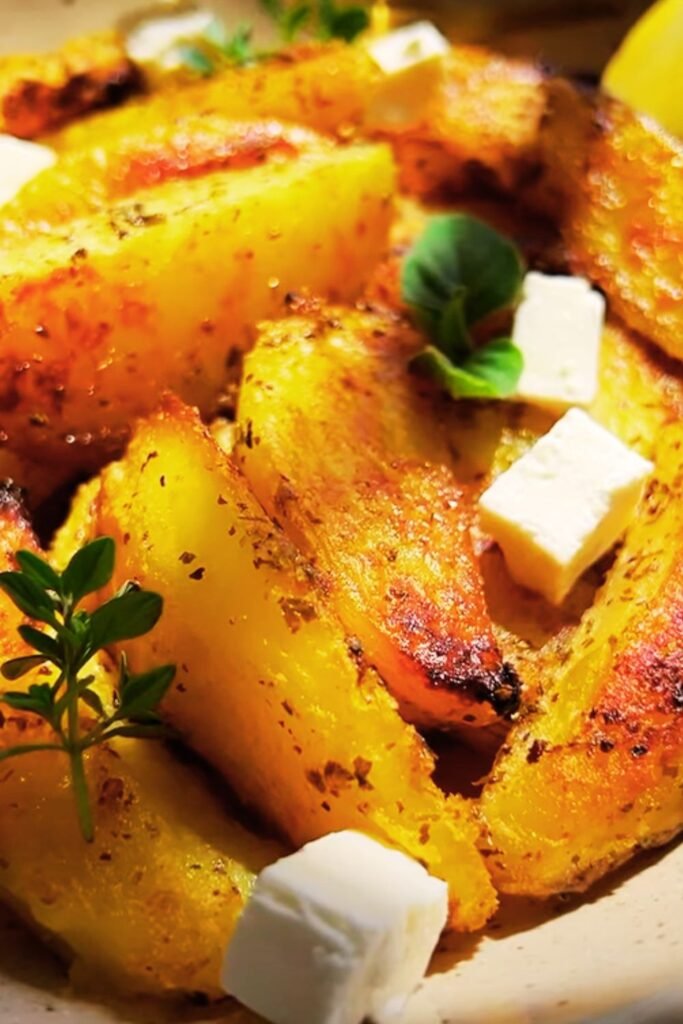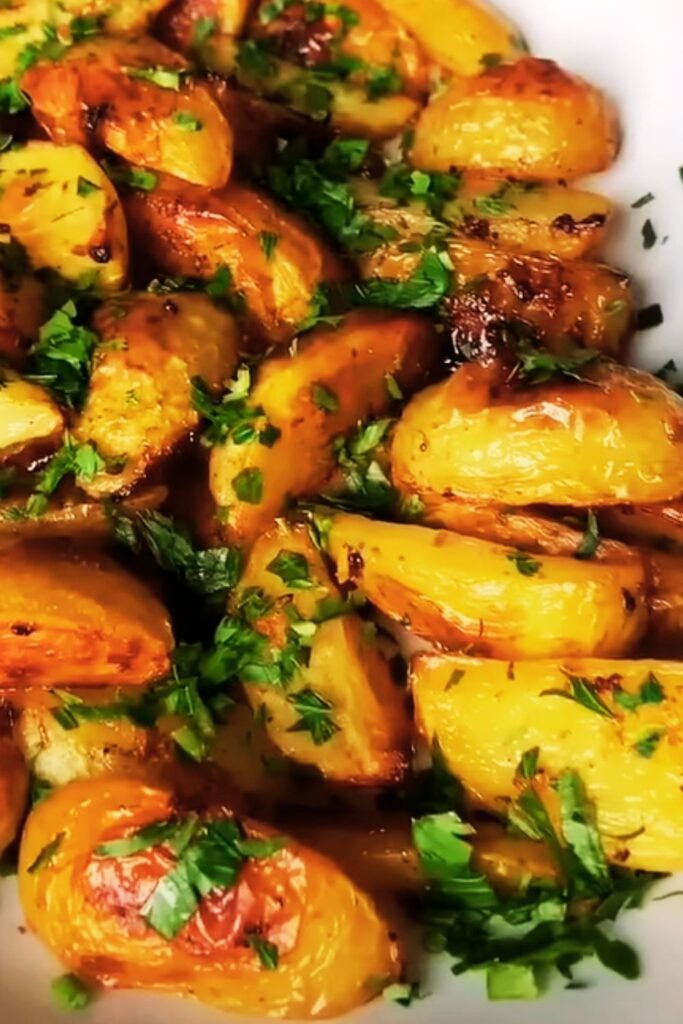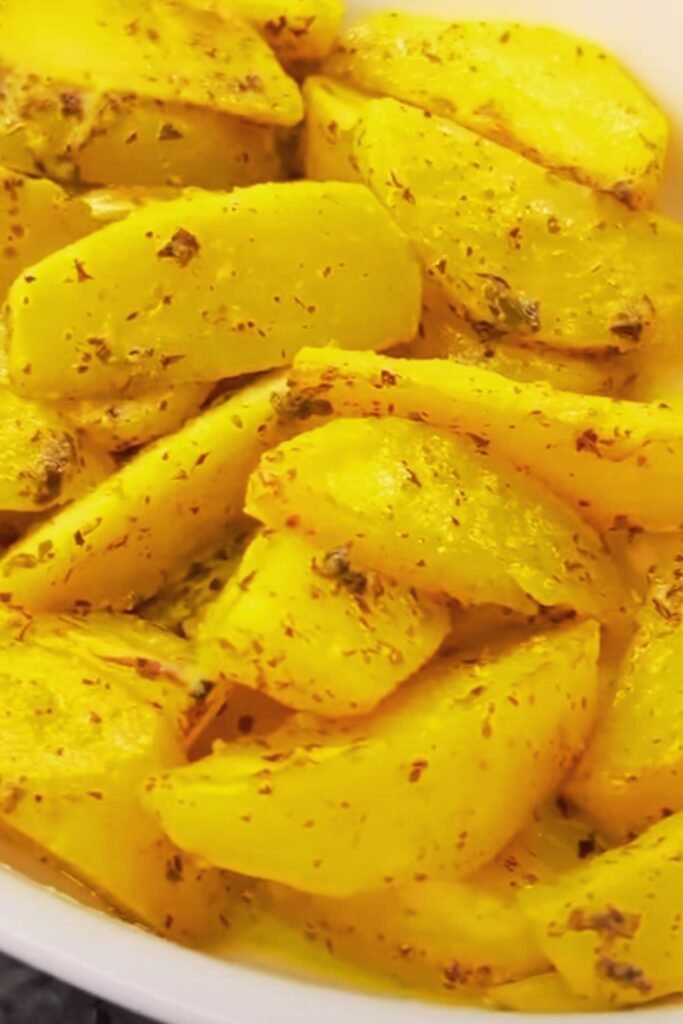I’ve been perfecting my roasted potato game for years, and I can confidently say that these lemon herb roasted potatoes are an absolute showstopper. There’s something magical about the combination of crispy exteriors, fluffy interiors, and that bright citrusy herb flavor that transforms humble potatoes into restaurant-quality side dishes.
When I first started making roasted potatoes, I’ll admit they were pretty lackluster. Soggy in some spots, burnt in others, and lacking any real flavor depth. But through countless kitchen experiments and a few spectacular failures, I’ve discovered the secrets to achieving potato perfection every single time.
Understanding the Science Behind Perfect Roasted Potatoes
The key to exceptional roasted potatoes lies in understanding what happens during the cooking process. When potatoes are exposed to high heat, the Maillard reaction occurs – this is the chemical process that creates those beautiful golden-brown surfaces and develops complex flavors. The moisture on the potato’s surface evaporates, allowing the natural starches to caramelize and create that coveted crispy exterior.
I’ve learned that the variety of potato makes a tremendous difference. Waxy potatoes like red potatoes or fingerlings hold their shape beautifully but don’t get quite as fluffy inside. Starchy potatoes like Russets become incredibly fluffy but can sometimes fall apart. That’s why I prefer using Yukon Gold potatoes – they strike the perfect balance between holding their shape and developing that dreamy, creamy interior texture.
Essential Potato Varieties for Roasting
Yukon Gold Potatoes : Medium-starch potatoes with thin, edible skins that crisp beautifully while maintaining creamy interiors
Red Potatoes : Waxy potatoes that hold their shape exceptionally well and have a slightly sweet, earthy flavor
Fingerling Potatoes : Small, elongated potatoes with thin skins and dense, buttery flesh that roasts evenly
Russet Potatoes : High-starch potatoes that become extremely fluffy inside but require careful handling to prevent breaking apart
The Foundation: Selecting and Preparing Your Potatoes
When I’m selecting potatoes at the market, I look for specimens that are firm to the touch with smooth, unblemished skin. I avoid any potatoes with green patches, sprouts, or soft spots – these indicators suggest the potatoes are past their prime and won’t deliver optimal flavor or texture.
Size consistency is crucial for even cooking. I always choose potatoes that are roughly the same size, or I cut larger ones to match smaller ones. This ensures every piece finishes cooking at the same time, preventing some from becoming overcooked while others remain underdone.
The preparation process begins with a thorough washing. I scrub the potatoes under cold running water using a vegetable brush to remove any dirt or debris. Since I prefer leaving the skins on for added texture and nutrition, this step is particularly important.

My Signature Lemon Herb Seasoning Blend
After years of experimentation, I’ve developed what I consider the perfect herb and spice combination for these potatoes. The blend balances earthy herbs with bright citrus notes and just enough heat to keep things interesting.
Primary Herb Components
Fresh Rosemary : Provides a pine-like, slightly bitter note that pairs beautifully with potatoes and stands up to high-heat roasting
Fresh Thyme : Offers subtle earthy and floral notes that complement without overwhelming other flavors
Fresh Oregano : Adds a warm, slightly bitter taste with hints of sweetness that enhances the overall herb profile
Fresh Parsley : Contributes brightness and freshness, best added after roasting to preserve its delicate flavor
Supporting Flavor Elements
The lemon component comes from both fresh zest and juice. I use a microplane grater to create fine lemon zest that distributes evenly throughout the potatoes, while a squeeze of fresh lemon juice at the end brightens the entire dish.
Garlic plays a supporting role, and I’ve found that using both fresh minced garlic and garlic powder creates layers of flavor. The fresh garlic caramelizes beautifully during roasting, while the powder provides consistent garlicky notes throughout.
Detailed Cooking Method and Techniques
My roasting technique has evolved considerably over the years. I now swear by a two-temperature approach that ensures crispy exteriors and perfectly cooked interiors every single time.
Pre-Roasting Preparation Steps
• Preheat your oven to 425°F (220°C) – this high temperature is crucial for achieving proper browning • Cut potatoes into uniform pieces, roughly 1½ to 2 inches in size for optimal cooking • Place cut potatoes in a large bowl and cover with cold water for 10 minutes to remove excess starch • Drain thoroughly and pat completely dry with clean kitchen towels • Return potatoes to the bowl and drizzle with olive oil, ensuring every piece is well-coated
The Roasting Process
I start by roasting the potatoes at 425°F for the first 20 minutes. This high heat jump-starts the browning process and begins developing that crucial crispy exterior. During this initial phase, I resist the temptation to move or flip the potatoes – letting them develop a proper crust on one side first.
After 20 minutes, I flip each potato piece carefully using a spatula, then continue roasting for another 15-20 minutes. The total cooking time typically ranges from 35-40 minutes, depending on the size of your potato pieces and your oven’s particular characteristics.

Advanced Techniques for Restaurant-Quality Results
One technique I’ve borrowed from professional kitchens is the parboiling method. By briefly boiling the cut potatoes for 3-4 minutes before roasting, I can rough up their surfaces slightly, creating more area for browning and ultimately crispier results.
Here’s how I execute this technique:
• Bring a large pot of salted water to boil • Add cut potatoes and cook for exactly 3-4 minutes • Drain immediately and let cool for 2-3 minutes • Gently shake the potatoes in the colander to rough up the surfaces • Proceed with oil coating and seasoning as usual
This method requires a bit more effort but delivers restaurant-quality results that never fail to impress dinner guests.
Nutritional Benefits and Health Considerations
Potatoes often get unfairly maligned in health discussions, but they’re actually quite nutritious when prepared thoughtfully. A medium potato provides significant amounts of potassium, vitamin C, and vitamin B6, along with dietary fiber when you keep the skins on.
| Nutrient | Amount per Medium Potato | % Daily Value |
|---|---|---|
| Potassium | 620mg | 18% |
| Vitamin C | 27mg | 30% |
| Vitamin B6 | 0.4mg | 20% |
| Fiber | 2.3g | 8% |
| Iron | 0.9mg | 5% |
| Magnesium | 24mg | 6% |
The herbs I use contribute additional antioxidants and anti-inflammatory compounds. Rosemary contains rosmarinic acid, which has been studied for its potential cognitive benefits. Thyme provides thymol, a compound with antimicrobial properties.
Serving Suggestions and Pairing Ideas
These lemon herb roasted potatoes complement an incredibly wide range of main dishes. I’ve served them alongside everything from simple grilled chicken to elaborate holiday roasts, and they never disappoint.
Protein Pairings
The bright, herbaceous flavor profile works particularly well with:
• Roasted chicken or turkey – the lemon notes enhance poultry’s natural flavors • Grilled or pan-seared fish – especially salmon, halibut, or cod • Lamb dishes – the rosemary creates a classic Mediterranean combination • Pork tenderloin or chops – the herbs complement pork’s mild sweetness • Vegetarian proteins like roasted tofu or tempeh
Vegetable Companions
I love creating complete roasted vegetable medleys by adding:
• Brussels sprouts (add them 10 minutes after the potatoes start roasting) • Carrots and parsnips (cut into similar-sized pieces) • Bell peppers and zucchini (add these during the last 15 minutes) • Cherry tomatoes (add during the final 10 minutes to prevent overcooking)

Troubleshooting Common Issues
Even with the best intentions, roasted potatoes can sometimes go wrong. I’ve encountered virtually every possible potato disaster over the years, so let me share solutions to the most common problems.
Problem: Soggy or Steam-Cooked Texture
This usually happens when potatoes are overcrowded on the baking sheet or not dried properly before roasting. The solution involves:
• Using a larger baking sheet or multiple sheets to give potatoes space • Ensuring potatoes are completely dry before adding oil • Not covering the baking sheet with foil, which traps steam
Problem: Uneven Cooking
When some potatoes are perfectly done while others remain hard, the issue is typically size inconsistency or oven hot spots:
• Cut all potatoes to uniform sizes • Rotate the baking sheet halfway through cooking • Consider using two racks and switching sheet positions mid-cooking
Problem: Burnt Exteriors with Raw Interiors
This suggests the oven temperature is too high or the potatoes are cut too large:
• Reduce temperature to 400°F and increase cooking time • Cut potatoes smaller, aiming for 1-1.5 inch pieces • Cover with foil if browning too quickly, then remove for final crisping
Storage and Reheating Guidelines
Leftover roasted potatoes keep well in the refrigerator for up to four days when stored in an airtight container. I’ve found that proper reheating is crucial for maintaining their texture and flavor.
Optimal Reheating Methods
Oven Method (Recommended) : Preheat oven to 400°F, spread potatoes on a baking sheet, and reheat for 8-10 minutes until heated through and crispy
Skillet Method : Heat a bit of oil in a large skillet over medium-high heat and pan-fry the potatoes until warmed and crispy
Air Fryer Method : Reheat at 375°F for 3-4 minutes, shaking the basket halfway through
I strongly advise against microwave reheating, as it makes the potatoes soggy and destroys the crispy texture you worked so hard to achieve.
Seasonal Variations and Creative Adaptations
One of the things I love most about this recipe is its adaptability. Throughout the year, I modify the herb blend to reflect seasonal availability and complement different meals.
Spring Adaptation
During spring, I incorporate fresh chives, dill, and early herbs from my garden. The combination creates a lighter, more delicate flavor profile that pairs beautifully with spring vegetables and lighter proteins.
Summer Version
Summer calls for Mediterranean influences. I add fresh basil, oregano, and sometimes a sprinkle of crumbled feta cheese during the last few minutes of roasting.
Fall and Winter Modifications
Colder months inspire heartier herb combinations. I might add sage, extra rosemary, and sometimes a touch of smoked paprika for warmth and depth.
Advanced Flavor Variations
After mastering the basic technique, I encourage experimenting with different flavor profiles. Here are some successful variations I’ve developed:
Asian-Inspired Version
• Replace herbs with fresh ginger, garlic, and scallions • Add a splash of soy sauce and sesame oil • Finish with toasted sesame seeds and cilantro
Mexican-Style Adaptation
• Use cumin, chili powder, and fresh cilantro • Add lime zest instead of lemon • Include diced jalapeños for heat
Indian-Spiced Variation
• Incorporate turmeric, cumin, and coriander seeds • Add fresh curry leaves if available • Finish with fresh cilantro and a squeeze of lime
Professional Tips for Consistent Results
Through years of making these potatoes, I’ve developed a set of reliable techniques that ensure success every time:
| Technique | Purpose | Result |
|---|---|---|
| Room temperature start | Even cooking from edge to center | Uniformly cooked potatoes |
| Single layer arrangement | Proper air circulation | Even browning and crisping |
| Preheated baking sheet | Immediate searing contact | Better initial crust formation |
| Minimal flipping | Undisturbed crust development | Superior texture contrast |
| Resting period | Moisture redistribution | Enhanced final texture |
The preheated baking sheet technique deserves special mention. By placing your empty baking sheet in the oven during preheating, you create an immediately hot surface that begins the browning process the moment the potatoes make contact.
Questions and Answers
Q: Can I prepare these potatoes ahead of time for entertaining?
Absolutely! I often prep the cut and seasoned potatoes up to 4 hours before serving. Store them covered at room temperature, then roast as directed. You can also partially roast them earlier in the day, then finish them in a hot oven just before serving to restore crispiness.
Q: What’s the best oil to use for roasting potatoes?
I prefer extra virgin olive oil for its flavor and high smoke point, but avocado oil works excellently too. Avoid oils with low smoke points like butter or delicate oils that might burn at high temperatures.
Q: How do I know when the potatoes are perfectly done?
Look for deep golden-brown exteriors and test with a fork – it should pierce easily through the center. The edges should look slightly crispy, and you might hear a subtle sizzling sound when you remove them from the oven.
Q: Can I use dried herbs instead of fresh ones?
Yes, but use about one-third the amount since dried herbs are more concentrated. Add dried herbs at the beginning of roasting, but save any fresh herbs for finishing to preserve their bright flavors.
Q: Why do my potatoes sometimes stick to the baking sheet?
This usually happens when there’s insufficient oil or the baking sheet isn’t hot enough initially. Make sure every potato piece is well-coated with oil, and consider using parchment paper for insurance, though it’s not always necessary with proper technique.
Q: Can I make these potatoes in an air fryer?
Definitely! Cook at 400°F for about 15-20 minutes, shaking the basket every 5 minutes. You might need to work in batches depending on your air fryer’s size, but the results are excellent.
Q: How can I make these potatoes more crispy?
Try the parboiling technique I mentioned earlier, ensure potatoes are completely dry before oiling, use a higher oven temperature (450°F), or finish them under the broiler for 1-2 minutes while watching carefully.
Q: What should I do if my potatoes are browning too quickly?
Lower the oven temperature to 400°F and cover loosely with foil until they’re cooked through, then remove the foil for the final 5-10 minutes to restore browning.
These lemon herb roasted potatoes have become my go-to side dish for almost any occasion. They’re elegant enough for dinner parties yet simple enough for weeknight meals. The combination of technique and flavor creates something truly special – crispy, golden exteriors giving way to fluffy, herb-infused interiors with that bright pop of lemon that makes everything taste more vibrant.
I hope you’ll try this recipe and make it your own. Don’t be afraid to experiment with different herb combinations or adjust the lemon to suit your taste preferences. The beauty of cooking lies in making recipes work for your palate and your family’s preferences. Happy cooking!